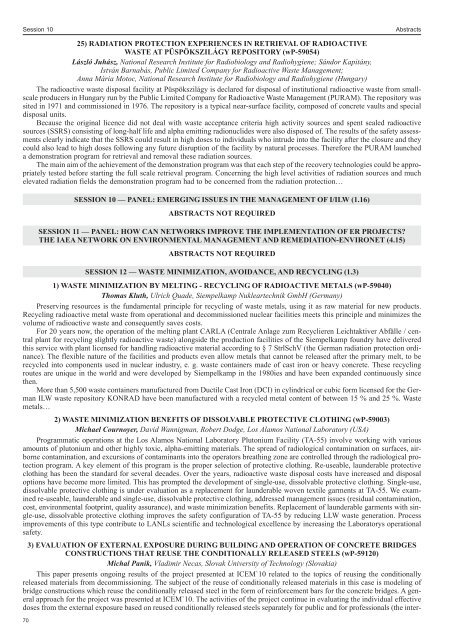ICEM11 Final Program 9.7.11pm_ICEM07 Final Program ... - Events
ICEM11 Final Program 9.7.11pm_ICEM07 Final Program ... - Events
ICEM11 Final Program 9.7.11pm_ICEM07 Final Program ... - Events
You also want an ePaper? Increase the reach of your titles
YUMPU automatically turns print PDFs into web optimized ePapers that Google loves.
Session 10 Abstracts<br />
25) RADIATION PROTECTION EXPERIENCES IN RETRIEVAL OF RADIOACTIVE<br />
WASTE AT PÜSPÖKSZILÁGY REPOSITORY (wP-59054)<br />
László Juhász, National Research Institute for Radiobiology and Radiohygiene; Sándor Kapitány,<br />
István Barnabás, Public Limited Company for Radioactive Waste Management;<br />
Anna Mária Motoc, National Research Institute for Radiobiology and Radiohygiene (Hungary)<br />
The radioactive waste disposal facility at Püspökszilágy is declared for disposal of institutional radioactive waste from smallscale<br />
producers in Hungary run by the Public Limited Company for Radioactive Waste Management (PURAM). The repository was<br />
sited in 1971 and commissioned in 1976. The repository is a typical near-surface facility, composed of concrete vaults and special<br />
disposal units.<br />
Because the original licence did not deal with waste acceptance criteria high activity sources and spent sealed radioactive<br />
sources (SSRS) consisting of long-half life and alpha emitting radionuclides were also disposed of. The results of the safety assessments<br />
clearly indicate that the SSRS could result in high doses to individuals who intrude into the facility after the closure and they<br />
could also lead to high doses following any future disruption of the facility by natural processes. Therefore the PURAM launched<br />
a demonstration program for retrieval and removal these radiation sources.<br />
The main aim of the achievement of the demonstration program was that each step of the recovery technologies could be appropriately<br />
tested before starting the full scale retrieval program. Concerning the high level activities of radiation sources and much<br />
elevated radiation fields the demonstration program had to be concerned from the radiation protection…<br />
SESSION 10 — PANEL: EMERGING ISSUES IN THE MANAGEMENT OF I/ILW (1.16)<br />
ABSTRACTS NOT REQUIRED<br />
SESSION 11 — PANEL: HOW CAN NETWORKS IMPROVE THE IMPLEMENTATION OF ER PROJECTS?<br />
THE IAEA NETWORK ON ENVIRONMENTAL MANAGEMENT AND REMEDIATION-ENVIRONET (4.15)<br />
ABSTRACTS NOT REQUIRED<br />
SESSION 12 — WASTE MINIMIZATION, AVOIDANCE, AND RECYCLING (1.3)<br />
1) WASTE MINIMIZATION BY MELTING - RECYCLING OF RADIOACTIVE METALS (wP-59040)<br />
Thomas Kluth, Ulrich Quade, Siempelkamp Nukleartechnik GmbH (Germany)<br />
Preserving resources is the fundamental principle for recycling of waste metals, using it as raw material for new products.<br />
Recycling radioactive metal waste from operational and decommissioned nuclear facilities meets this principle and minimizes the<br />
volume of radioactive waste and consequently saves costs.<br />
For 20 years now, the operation of the melting plant CARLA (Centrale Anlage zum Recyclieren Leichtaktiver Abfälle / central<br />
plant for recycling slightly radioactive waste) alongside the production facilities of the Siempelkamp foundry have delivered<br />
this service with plant licensed for handling radioactive material according to § 7 StrlSchV (the German radiation protection ordinance).<br />
The flexible nature of the facilities and products even allow metals that cannot be released after the primary melt, to be<br />
recycled into components used in nuclear industry, e. g. waste containers made of cast iron or heavy concrete. These recycling<br />
routes are unique in the world and were developed by Siempelkamp in the 1980ies and have been expanded continuously since<br />
then.<br />
More than 5,500 waste containers manufactured from Ductile Cast Iron (DCI) in cylindrical or cubic form licensed for the German<br />
ILW waste repository KONRAD have been manufactured with a recycled metal content of between 15 % and 25 %. Waste<br />
metals…<br />
2) WASTE MINIMIZATION BENEFITS OF DISSOLVABLE PROTECTIVE CLOTHING (wP-59003)<br />
Michael Cournoyer, David Wannigman, Robert Dodge, Los Alamos National Laboratory (USA)<br />
<strong>Program</strong>matic operations at the Los Alamos National Laboratory Plutonium Facility (TA-55) involve working with various<br />
amounts of plutonium and other highly toxic, alpha-emitting materials. The spread of radiological contamination on surfaces, airborne<br />
contamination, and excursions of contaminants into the operators breathing zone are controlled through the radiological protection<br />
program. A key element of this program is the proper selection of protective clothing. Re-useable, launderable protective<br />
clothing has been the standard for several decades. Over the years, radioactive waste disposal costs have increased and disposal<br />
options have become more limited. This has prompted the development of single-use, dissolvable protective clothing. Single-use,<br />
dissolvable protective clothing is under evaluation as a replacement for launderable woven textile garments at TA-55. We examined<br />
re-useable, launderable and single-use, dissolvable protective clothing, addressed management issues (residual contamination,<br />
cost, environmental footprint, quality assurance), and waste minimization benefits. Replacement of launderable garments with single-use,<br />
dissolvable protective clothing improves the safety configuration of TA-55 by reducing LLW waste generation. Process<br />
improvements of this type contribute to LANLs scientific and technological excellence by increasing the Laboratorys operational<br />
safety.<br />
3) EVALUATION OF EXTERNAL EXPOSURE DURING BUILDING AND OPERATION OF CONCRETE BRIDGES<br />
CONSTRUCTIONS THAT REUSE THE CONDITIONALLY RELEASED STEELS (wP-59120)<br />
Michal Panik, Vladimir Necas, Slovak University of Technology (Slovakia)<br />
This paper presents ongoing results of the project presented at ICEM`10 related to the topics of reusing the conditionally<br />
released materials from decommissioning. The subject of the reuse of conditionally released materials in this case is modeling of<br />
bridge constructions which reuse the conditionally released steel in the form of reinforcement bars for the concrete bridges. A general<br />
approach for the project was presented at ICEM`10. The activities of the project continue in evaluating the individual effective<br />
doses from the external exposure based on reused conditionally released steels separately for public and for professionals (the inter-<br />
70
















